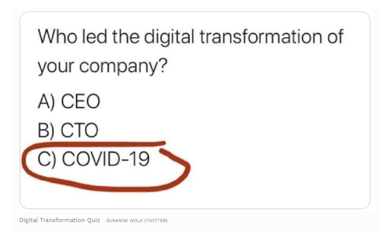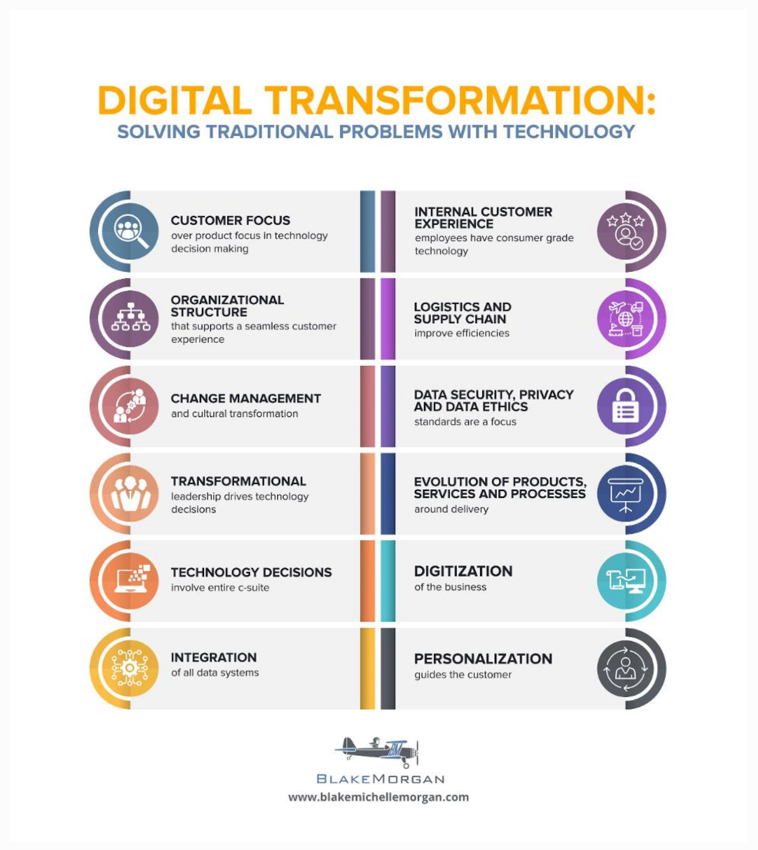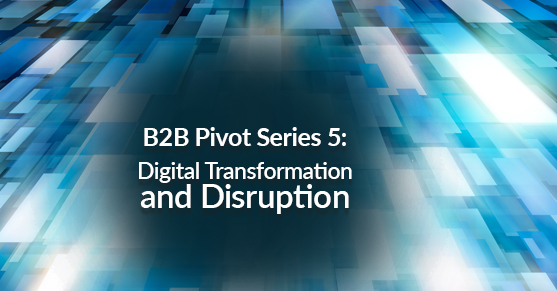Digital transformation as a name for the process it describes is a misnomer. The core of the name is the result: digital transformation is how to deliver ever-greater customer value efficiently, effectively, and proactively. It’s no longer business as usual, but business as customers drive it. Digital transformation is no longer optional for businesses; disruption is facilitating and escalating it. Following is what you need to know about investing in digital transformation sooner than later to thrive post-disruption.
Business must evolve to remain relevant and, therefore, profitable.
Transformation is the process of evolution.
Digital transformation is the catch-all phrase to describe how companies can ensure their sustainability by delivering ever-greater customer value.
The essential outcome of recent market and economic disruption is that digital transformation is no longer optional. Disruption is simply an amplifier of what was already happening in your business. Digital transformation probably has started in some way in your company, whether it’s called that or not, to adjust to our ‘new normal’.
Business has to evolve in order to stay relevant. Relevance leads to profit. Transformation is the process of evolution so, consequently, digital transformation has become kind of a catch-all phrase to describe how companies can ensure their sustainability by delivering ever-greater customer value. In the end, it’s about a natural evolution of business going to the next level of success.
Defining Digital Transformation
Let’s first define digital transformation. Digital transformation is the process companies proactively take to align people, process and presence for profit. This includes driving to:
– Become more customer-centric (internal and external),
– Leverage technology to build relationships, and,
– Deliver even greater value with fewer resources.
The net result is that organizations become more customer centric, innovative, and predictably responsive. In other words, a process of “transformation” has to be adopted to stay ahead of customer demands and remain sustainably competitive in business. Customers are both internal (users who deliver solutions) and external (purchasers and consumers of solutions).
Brian Solis is an industry analyst who says digital transformation is about two different simultaneous upgrades. On the one side, there’s the internal-facing efforts focused on digitizing and modernizing operational systems, which is the foundation of business itself; secondarily, external efforts are aimed at developing a modern platform to run a digital business with its offerings in the ecosystem and the customer journey itself as an experience that unfolds at each touchpoint. Essentially, this means there are really two different kinds of upgrades happening in any digital transformation process.
Innately, digital transformation includes next-level customer experience in self-service capabilities, “invisible” (seamless) technology where systems talk to each other, and, predictive, personalized offers and solutions. It means streamlining to deliver ever-greater customer value with lean resources.
It also requires future-proof IT systems, meaning they are 1) stable, secure and scalable, 2) expandable to accommodate needs as they present, and, 3) adjustable to meet emerging compliance/regulations.
 Without purpose, direction or the ability to connect these dots in a value chain, digital transformation doesn’t go anywhere. Digitization is about implementing new technologies to improve existing business models and methods. Developing a digital business means using online technology and expertise to create and deliver new value through products, services, and experiences overall. Digital transformation is a comprehensive upshift in all systems – people, process and presence. It is important to recognize those distinctions.
Without purpose, direction or the ability to connect these dots in a value chain, digital transformation doesn’t go anywhere. Digitization is about implementing new technologies to improve existing business models and methods. Developing a digital business means using online technology and expertise to create and deliver new value through products, services, and experiences overall. Digital transformation is a comprehensive upshift in all systems – people, process and presence. It is important to recognize those distinctions.
One of the most ironic things about digital transformation is the key failure point is not the tech but the people involved. That makes sense because, when people are in an adaptive process, they’re reeling and figuring out what’s going on, in which case digital transformation becomes one more stressor to learn and adapt through for growth.
For digital transformation to be successful, better communication must be used throughout the process. Make sure there are goals and accountability, that politics or egos do not get in the way of progress, that value for everyone is emphasized. Ensure your corporate culture promotes innovation and resilience, that people are in touch with what’s happening in the market so your brand is not perceived as ‘tone-deaf’ in a disrupted marketplace. Make sure your brand and your people demonstrate consistent empathy and that you are connected where people are looking to connect on their terms. In the absence of these things, Brian Solis coined a phrase – Digital Darwinism – where legacy organizations that do not evolve with current-to-market-expectations behaviors, mindsets, and processes become obsolete. Companies are facing this very real choice over and over again, especially during disruption.
Impact of COVID-19
COVID-19 has brought both negative and positive impacts to business and digital transformation. According to a study by TechRadar.com, the top three negatives are seen to be a significant decline in sales performance, an inability to resume production, and an inability to visit customers.
However, there are also exciting positive impacts including improved corporate ability of long-distance collaborative work, gaining an ability of online marketing and business development, and lastly, wide recognition of the value of digital transformation and information technology among all employees. So COVID-19 has heightened the urgency in working through a digital transformation process.

Senior Director Analyst at Gartner, Sandy Shen, said “this is a wake-up call for organizations that have placed too much focus on daily operational needs at the expense of investing in digital business and long-term resilience. Businesses that can shift technology capacity and investments to digital platforms will mitigate the impact of the outbreak and keep their companies running smoothly now and over the long-term.”
Futurist Bernard Marr said, “people turning to digital tools to keep some semblance of normality. It’s been imperative to digitally transform our workplaces to operate effectively (or at all). Those companies that are able to use technology well to keep going and rethink their business model for the future by fast-tracking digital transformation will be ones ahead of their competition.”
According to CIO.com, it’s important to invest proactively now to win later. According to Forrester Research, organizations that contained costs during past disruptions felt pressure from companies that took a pro-investment approach when the global economy rebounded. Boosting business resiliency by investing in technology, automation, the cloud, improved customer experience, scalability, self-service, data analytics and more is a vital and preemptive strategy.
One of the things I think XTIVIA needs to emphasize more is that XTIVIA has in-house expertise that covers a lot of different areas, including the above. When you work with XTIVIA, you get access to the whole ecosystem – it’s impressive. That means you don’t have to isolate projects by partner, or not know who to call when there’s a problem, or have to search for deep expertise for a complex issue – XTIVIA has it covered. XTIVIANs also understand business outcomes and think strategically about desired customers outcomes so they invest in relationships through conversations to learn. If your company is at a choice point about technology implementation needs, it is a good idea to invest in a chat.

An article recently appeared on Forbes where author Blake Morgan defined the 12 steps of digital transformation. His position is that it’s about solving traditional problems with technology. These 12 things – customer focus, organizational structure, change management, transformational leadership, technology decisions, integration of all data systems, internal customer experience, logistics and supply chain, data security, privacy and data ethics, evolution of products, services and processes, digitization, and personalization – are each substantial. This graphic is deceptively simple but it does show how digital transformation touches on each aspect of an organization.
Digital Transformation in Your Company
What does digital transformation look like for your company, especially during disruption? The answer is nobody knows. Digital transformation is ever-evolving and never-ending. It is continuous improvement for every process, protocol, and position within your company. One way to determine your best approach is to think strategically about your customer’s experience and satisfaction, then reverse-engineer the process to find the gaps, deficiencies, and opportunities for upgrade. Use that same approach with your internal customers, your users, to improve their experience in delivering your solutions as well.
Digital transformation, as I shared earlier, is really about people. People make the difference in terms of making or breaking digital transformation. And again, digital transformation is just… I need to come up with a new word for that. I don’t know. It’s business evolution. So anyway, this…We just have a ton of stuff on XTIVIA’s website and our YouTube channel. We have downloadable PDFs. We have all kinds of things. And then feel free of course, to reach out and ping me directly. You’ll see my information on the last slide here. But the bottom line is that digital transformation is a very personalized process.to ensure your company’s long-term sustainability by streamlining and delivering ever-greater customer value.
This “new normal” caused by disruption is an opportunity to get digital transformation right in creating a next-level business landscape that places people and their experiences at the center of brands and decision-making. The path forward is to see, upgrade, and even transcend what’s been up until now in terms of processes, priorities, value chains around supply and demand… and companies won’t be able to achieve next-level status by remaining in survival mode. You must go past just ‘keeping up’ to being resilient and pivoting for success. That means understanding what you no longer want or need to do, what is not a good use of resources going forward, what needs to be upgraded, and what needs to be innovated. This time – now – is a milestone in humanity that is creating not just a ‘new normal’ we can’t really see yet but a new interpretation and definition of business going forward.
There are exponential approaches you can take in digital transformation – like any other complex process, it’s highly personalized. There is no book that will tell you exactly what your company should do. Meanwhile, the need for digital transformation is escalated by disruption turning the economy upside down. Disruption amplifies what was already happening in your business – it is now surfacing opportunities for growth and innovation, especially as your customers’ needs, wants, priorities, and buying patterns are changing. Use the generative energy of disruption to fuel proactive progress in your company’s digital transformation process and long-term sustainability. It is the investment that will pay you back.
To speak to a trusted advisor about your technology needs for digital transformation, give XTIVIA a call at 888-685-3101, ext. 2.


Lynn – I saw that you had the term “Digital Transformational Specialist” in your LinkedIn description and was curious to know what you meant by that. Then I happily found a link to this informative article. Thanks.